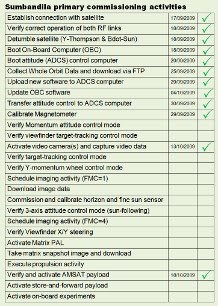Initial images taken by the main payload imager, indicated that a focus shift had occurred, probably due to a combination of launch vibrations and an elevated thermal environment (higher than expected temperatures). The images furthermore indicated that this shift was towards the blue image band (away from red).
The imager is designed with a built-in mechanical refocusing mechanism, so we attempted the refocusing of the imager by making use of a live PAL video feed (9 Dec 2009). This feed originates from the matrix sensor that is co-located on the focal plane with two line sensors. The focusing was done on four steps as shown below with the snapshot images (cropped) from the matrix sensor. These images have a resolution of 8.4m compared to the resolution of the main imager of 6.25m. A marked improvement was visible on both the video feed and the snapshot images that were downloaded afterwards. The focus was shifted by 300um towards the red band.
High-resolution images taken by the line sensors after the focus effort confirmed that the imager is now again in focus.
The imager is designed with a built-in mechanical refocusing mechanism, so we attempted the refocusing of the imager by making use of a live PAL video feed (9 Dec 2009). This feed originates from the matrix sensor that is co-located on the focal plane with two line sensors. The focusing was done on four steps as shown below with the snapshot images (cropped) from the matrix sensor. These images have a resolution of 8.4m compared to the resolution of the main imager of 6.25m. A marked improvement was visible on both the video feed and the snapshot images that were downloaded afterwards. The focus was shifted by 300um towards the red band.
High-resolution images taken by the line sensors after the focus effort confirmed that the imager is now again in focus.



No comments:
Post a Comment